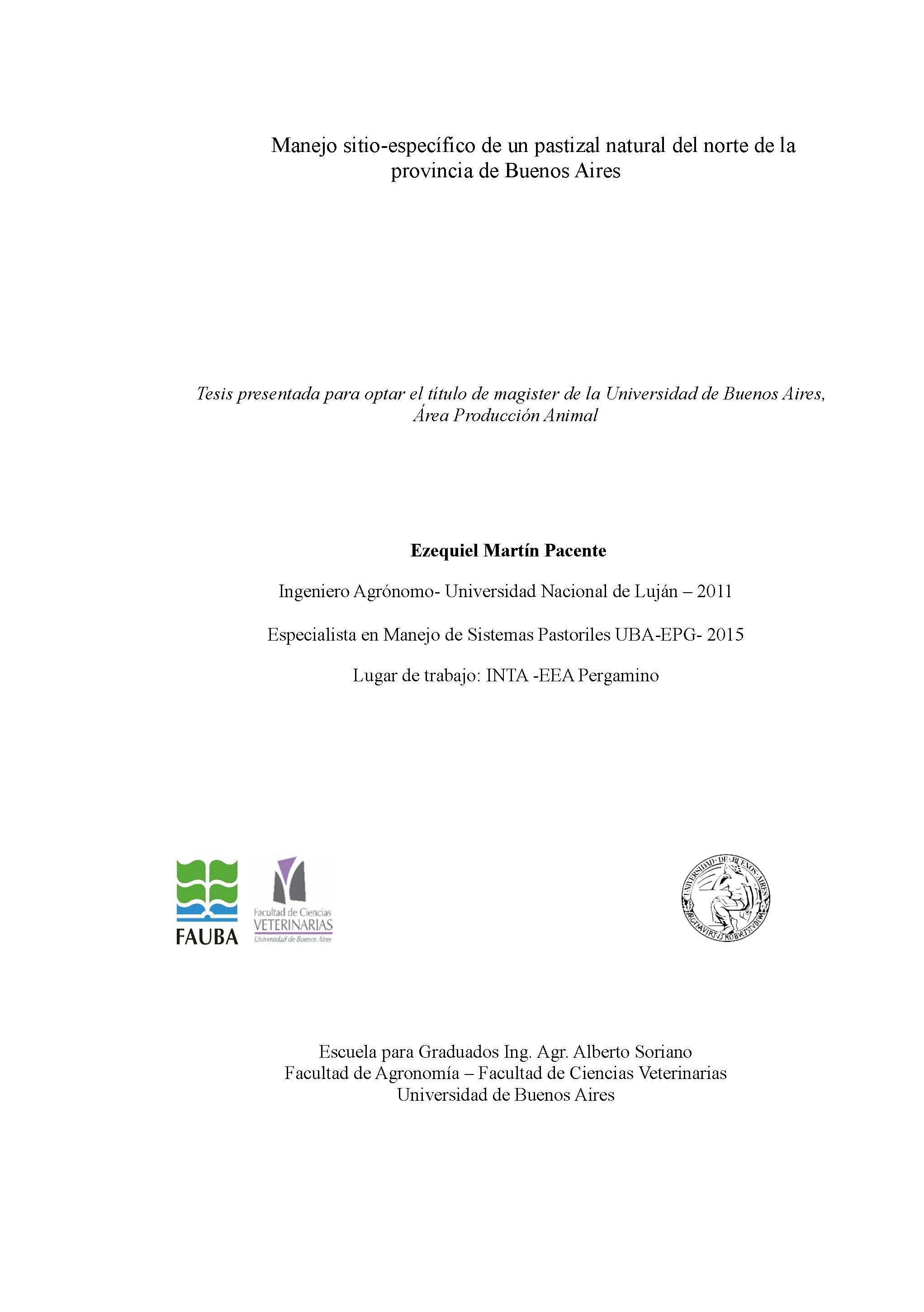Ver ítem
- xmlui.general.dspace_homeCentros Regionales y EEAsCentro Regional Buenos Aires NorteEEA PergaminoTesisxmlui.ArtifactBrowser.ItemViewer.trail
Manejo sitio-específico de un pastizal natural del norte de la provincia de Buenos Aires
Resumen
En la Región Pampeana la producción ganadera, en especial de cría, se encuentra en ambientes de menor aptitud con alta heterogeneidad edáfica. En estos, los procesos de hidromorfismo y halomorfísmo son comunes. Esta heterogeneidad se refleja en la
vegetación, determinando diferentes comunidades de pastizales naturales. Al poder identificarlas, es posible aplicar prácticas de manejo sitio-específico. El objetivo de la investigación es evaluar el efecto de
[ver mas...]
En la Región Pampeana la producción ganadera, en especial de cría, se encuentra en ambientes de menor aptitud con alta heterogeneidad edáfica. En estos, los procesos de hidromorfismo y halomorfísmo son comunes. Esta heterogeneidad se refleja en la
vegetación, determinando diferentes comunidades de pastizales naturales. Al poder identificarlas, es posible aplicar prácticas de manejo sitio-específico. El objetivo de la investigación es evaluar el efecto de estas prácticas sobre la productividad primaria neta área (PPNA) y calidad de la oferta forrajera del pastizal. Se trabajó sobre tres comunidades vegetales del pastizal natural, denominadas de acuerdo a su composición florística predominante, festuca alta (FA), raigrás-sporobolus (R-S) y agropiro alargado (AA), situadas sobre distintos tipos de suelos: Argiudol vértico fase hidromórfica, Natracualf típico y Natracualf típico fase erosionada, respectivamente. En cada comunidad se comparó la PPNA y la calidad de la oferta forrajera obtenida bajo tres tratamientos: sitio-específico, bajos insumos y control. Se simuló la PPNA y la oferta de proteína bruta del pastizal con cuatro opciones de manejo y con dieciocho proporciones de cada comunidad. No se logró incrementar la PPNA de las comunidades con el manejo sitio-específico. Sin embargo, en las comunidades de raigrás-sporobolus y agropiro se modificó el patrón de distribución de la productividad primaria. Las leguminosas se implantaron en el manejo sitio-específico pero no persistieron, y en el corte en que contribuyeron con mayor proporción, el aporte de proteína del forraje fue significativo sólo en la comunidad de raigrás-sporobolus. Con el manejo sitio-específico se incrementó el fósforo en el suelo en las comunidades de festuca y agropiro. En esta última, la incorporación de yeso agrícola no logró corregir el pH y el sodio. La productividad primaria y la proteína bruta simulada del pastizal fue superior con un manejo sitio-específico eficiente en relación con los tratamientos bajos insumos y control.
[Cerrar]
In the Pampa region, livestock production, especially breeding, is found in environments with less aptitude that have high edaphic heterogeneity. In these
environments the processes of hydromorphism and halomorphism are common. This edaphic heterogeneity is reflected in the vegetation, determining different communities of natural grasslands. That by being able to identify them, it is possible to apply sitespecific management practices. The objective of
[ver mas...]
In the Pampa region, livestock production, especially breeding, is found in environments with less aptitude that have high edaphic heterogeneity. In these
environments the processes of hydromorphism and halomorphism are common. This edaphic heterogeneity is reflected in the vegetation, determining different communities of natural grasslands. That by being able to identify them, it is possible to apply sitespecific management practices. The objective of the research is to evaluate the effect of these practices on the net primary productivity area (PPNA) and quality of the pasture forage supply It was worked on three plant communities of a natural pasture, named according to their predominant floristic composition, tall fescue (FA), ryegrasssporobolus (R-S) and elongated wheatgrass (AA), located on different types of soils: Argiudol vértico hydromorphic phase, Natracualf típico and Natracualf típico eroded phase, respectively. In each community compared the PPNA and the quality of the forage supply obtained under three treatments: Site-specific management, low inputs and a control treatment. It was simulated PPNA and the offer of crude protein of the grassland with four management options and eighteen proportions of each community. It was not possible to increase the production of the evaluated communities with the sitespecific management. However, in the raigrás-sporobolus and agropiro communities, the pattern of distribution of primary productivity was modified. The legumes were well implanted but did not persist and in the cut that there was a greater proportion of them, the contribution of forage protein was significant only in the community of raigrás-sporobolus. The phosphorus content in the soil was increased in the
communities of fescue and agropiro and in the latter it was not possible to correct the pH and the PSI. The PPNA and the offer PB simulated of the pasture was superior with an efficient site-specific management in relation to the treatments of low inputs and control.
[Cerrar]

Director de Tesis
Descripción
Tesis presentada para optar el título de Magister de la Universidad de Buenos Aires, área Producción Animal, en abril 2018
Fecha
2018
Editorial
Universidad de Buenos Aires
Formato
pdf
Tipo de documento
tesis de maestría
Palabras Claves
Derechos de acceso
Abierto
 Excepto donde se diga explicitamente, este item se publica bajo la siguiente descripción: Creative Commons Attribution-NonCommercial-ShareAlike 2.5 Unported (CC BY-NC-SA 2.5)
Excepto donde se diga explicitamente, este item se publica bajo la siguiente descripción: Creative Commons Attribution-NonCommercial-ShareAlike 2.5 Unported (CC BY-NC-SA 2.5)


